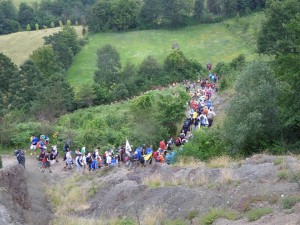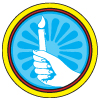The massacre of Srebrenica (a town in eastern Bosnia and Herzegovina) was the worst episode of mass murder within Europe since World War II. In the context of the Bosnian war, it refers to the slaying of more than 8,000 Bosnian Muslims, including Roma, boys and men, perpetrated by Bosnian Serb forces in Srebrenica, in July 1995. In addition to the killings, more than 20,000 civilians were expelled from the area—a process known as ethnic cleansing.
War II. In the context of the Bosnian war, it refers to the slaying of more than 8,000 Bosnian Muslims, including Roma, boys and men, perpetrated by Bosnian Serb forces in Srebrenica, in July 1995. In addition to the killings, more than 20,000 civilians were expelled from the area—a process known as ethnic cleansing.
The International Criminal Tribunal for the Former Yugoslavia—established before the massacre—concluded that the killings at Srebrenica, compounded by the mass expulsion of Bosnian civilians, amounted to genocide.
It pinned principal responsibility on senior officers in the Army of Republika Srpska (Bosnian Serb army). But the United Nations and its Western supporters, following a quite lengthy process, tend slowly to accept a portion of the blame for having failed to protect the Bosnian men, women, and children in Srebrenica, which in 1993 the UN Security Council had formally designated a “safe area.”
In 1992, Bosnian Serb forces targeted Srebrenica in a campaign to seize control of a block of territory in eastern Bosnia and Herzegovina. To do so, they believed, required the expulsion of the territory’s Bosnian inhabitants, who opposed annexation.
In March 1995 Radovan Karadžić, president of the self-declared autonomous Republika Srpska (Bosnian Serb Republic), decided to physically separate Srebrenica from Zepa in order to prevent the communication between the two enclaves. He directed his military forces to “create an unbearable situation of total insecurity with no hope of further survival or life for the inhabitants of Srebrenica.”
Srebrenica, isolated, surrounded, completely dependent on the assistance of the international community became an easy target.
The offensive started at the beginning of July 1995, with Bosnian Serb forces advancing from the south and burning Bosnian homes along the way. Amid chaos and terror, thousands of civilians fled Srebrenica for the nearby village of Potočari, where a contingent of about 200 Dutch peacekeepers was stationed but later failed in protecting this population.
On July 11, Bosnian Serb military leader Ratko Mladić strolled through Srebrenica and, in a recorded statement said, “We give this town to the Serb nation.…The time has come to take revenge on the Muslims.”
Muslims males (men but also young boys) were explicitly targeted. They were lured away from their families and they were killed in the nearby forests by the Serbian army.
In fact, on the night of July 11, a column of more than 10,000 Bosnian men set off from Srebrenica through dense forest in an attempt to reach safety. Beginning the following morning, Bosnian Serb officers used UN equipment and made false promises of security to encourage the men to surrender; thousands gave themselves up or were captured, and many were subsequently executed. Other Bosnians were forced out of Potočari that day through the use of terror, including individual murders and rapes committed by Bosnian Serb forces. The women, children, and elderly were placed aboard buses and driven to Bosnian-held territory.
The Serbian army pursued the hunt and the executions in the region at least until 16 of July.
If we hear about the war in Yugoslavia at school, I realize the extent to which information is missing in education system. Why don’t we hear more about the genocide of Srebrenica? And the other ones?
I was revolted to see how ignorant I was about it, even more so because many people around me were in the same situation.
This is why, when we received the invitation to take part in the march Mira and the commemoration of the genocide of Srebrenica, I got the strong feeling it was really important to be there and show the solidarity between people. Because the massacre has not been really recognized yet. Because we can not let the victims to fall into oblivion. Because real awareness and deep understanding between people is the only way to prevent history from repeating itself.
By walking through the beautiful forests and mountains in the Srebrenica region nobody could imagine that this wonderful landscape has been the theatre of one of the biggest atrocities perpetuated by humans. Indeed, 20 years ago the peaceful area changed into horror.
I am still not able to understand how we could reach that point. How human beings could once decide not to recognize other human beings as equal? There is no answer, there is no logic. There is nothing to understand because it goes so far away from human essence and values. It had no aim but sufferance and extermination. This only thought is scaring but we have to face it because it was a reality and because it is not over.
The way from Nezuk to Potosari is physically challenging but the difficulty is much more connected to emotions, feelings coming out by walking the way of the victims of the massacre. We remember these men trying to escape, living in constant fear, walking for days, without food, without anything else that what they could find on their way.
The pain will never go. Today investigations and researches for bodies are still running.
The process of locating the graves and identifying the victims was complicated by a well-organized effort undertaken by Bosnian Serb forces to hide traces of the Srebrenica crimes. Soldiers used heavy tractors and backhoes to dig up mass graves and moved the disinterred remains to distant sites. It required years of expertise and (DNA-) analysis to piece together exactly where the killings had occurred and how the bodies had been moved among an estimated 80 mass grave sites.
It was discovered later that many of the victims of the massacre had had their arms and feet bound. Many of the bodies also showed signs of mutilation.
Pieces of body are found separated from each other, distanced from many kilometers sometimes and thousands of bodies have not been found yet.
This means, thousands of wives, thousands of daughters and sons don’t have a grave to visit and pray.
And who cares about the entire families, exterminated, and now disappearing in the anonymity for lack of available genetic materials?
We, as non victims, will never completely understand it since we haven’t experienced the same.But trying to feel a little bit more what it means for these families, these communities is a huge step.
I’m persuaded that in order to prevent the history from repeating itself, sharing information is necessary but not enough. We have to unit people on a deeper understanding, a personal one.
One of the questions I was asking me repeatedly throughout the journey was the following: how the remaining people, survivors of the genocide, who all had to endure unbelievable hard conditions, who lost so many of their loved ones can keep going without starting a bloody revenge?
I think this is the most beautiful aspect that I remember from this experience and it is a real lesson of peace.
The way of the victims is at the same time the way of the survivors. Men who shown an unbelievable strength and solidarity between each other to resist, get out of the context of hate and violence and allow a better future for their families, their communities. The men who crossed the mountains, seeing so many of their friends disappearing and somehow found the courage to continue.
We have to talk about their fight, their courage which overpasses all limits.
And by survivors it is also important to mention all these women, often mothers of little children who found the strength to leave the country motivated by the hope of having a normal life again.
As we commemorate the death of so many of us, the courage of these people also has to be remembered. The strength of those who find a way to escape, drawing a line under their past and everything they had knew before, taking risks in order to save their children, the strength of those who stayed also, and are able, after facing death and horror, to share with the others in such a beautiful way, to welcome all instead of fostering feelings of hate and revenge.
I feel grateful that I could go there, met people with whom I could speak or simply share some hours of walk.
Coming from outside I was afraid of not feeling legitimated to be there because this would not be part of my history, to be seen as a stranger or worse as a tourist. But I was completely wrong.
I can’t describe how impressed I was by these people, from children to elderly, women, men, very well trained and sportive people as well as handicap people, originally from Bosnia or from abroad, all walking together. The brotherhood feeling was deep, everyone taking care of the others.
We all have to be there, we all have to show that we care if we want a real change. Waiting for governmental official speeches is not the solution and if finally one day it happens, it won’t change so much for the people. The solidarity and the recognition has to come from us, this is what I strongly believe in.
Walking together in every sense is what we have to do.
All of them deserve to see the recognition inside and outside the country.
All of them deserve to see their children in peace, released of the danger to be persecuted again.
All of them deserve to see the region regaining the liveliness it used to be.
Only all together we can reach that point.


